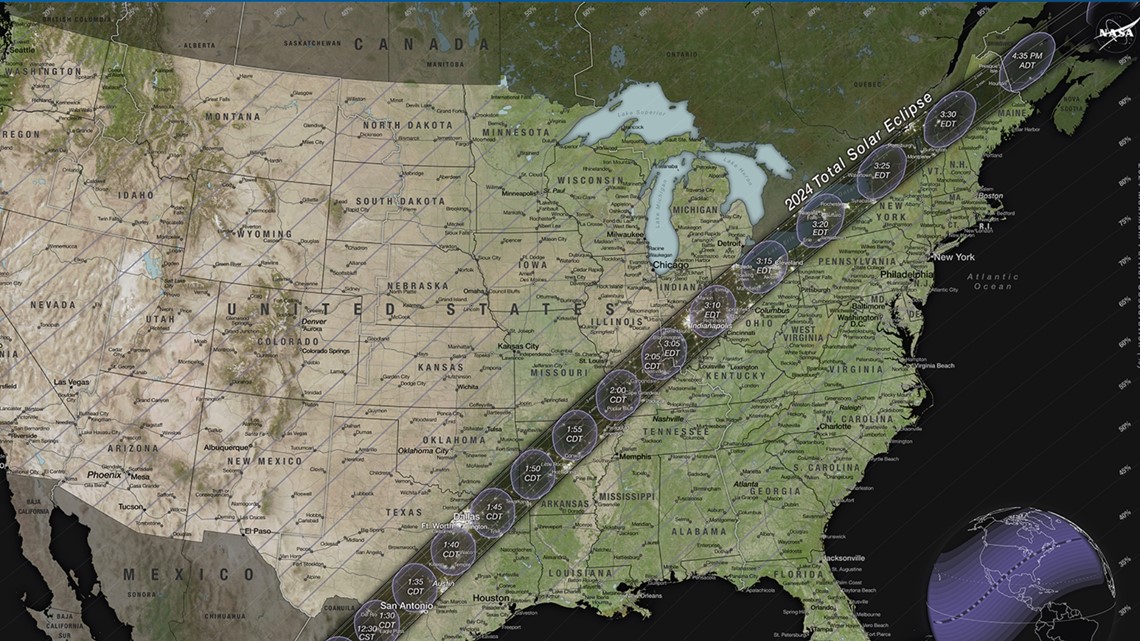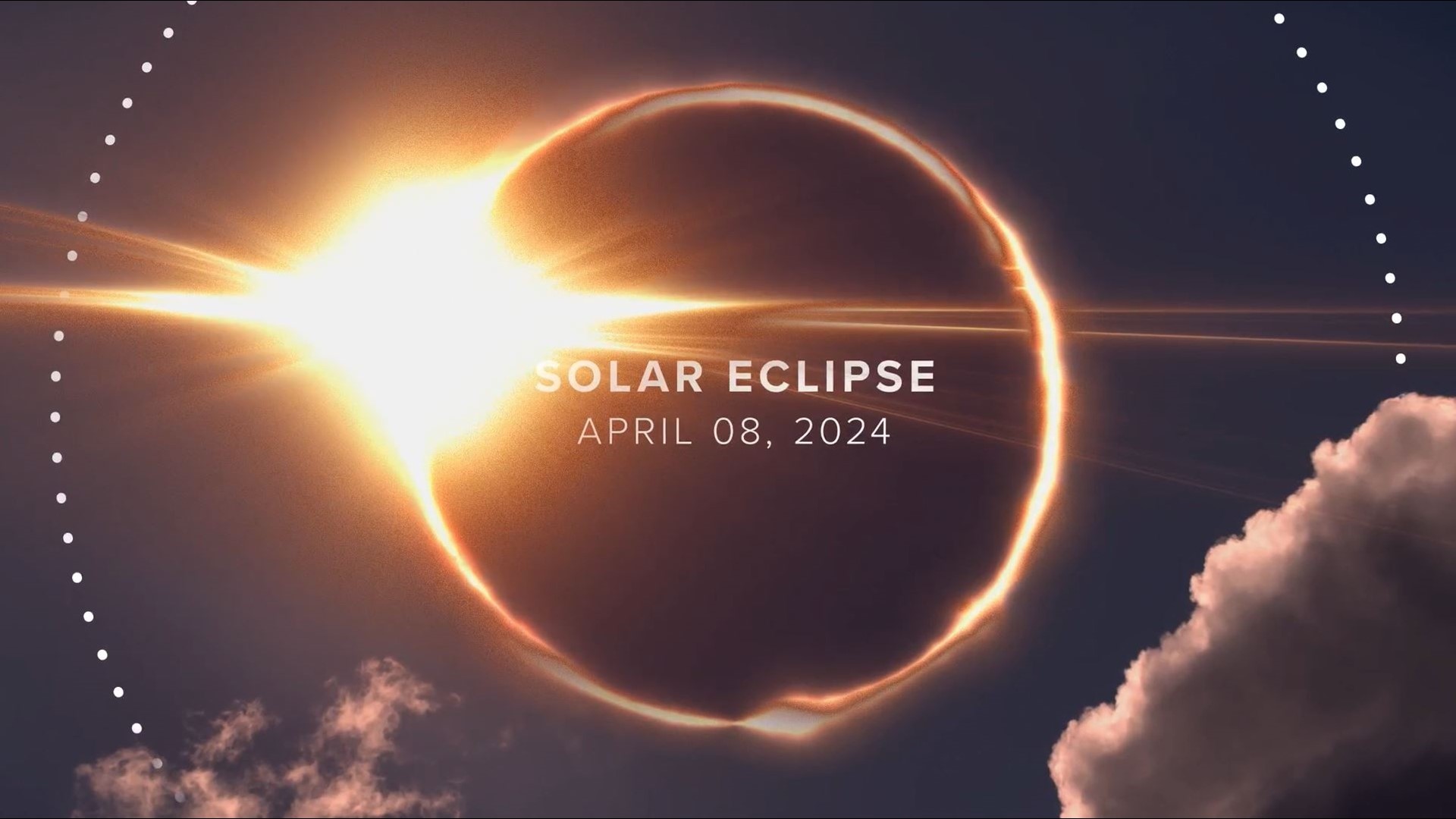WASHINGTON — It's been nearly seven years since North America experienced a cross-country total solar eclipse.
In one month, a bigger and longer solar eclipse will captivate audiences across the US as it travels from Texas to Maine. Those in the 115-mile-wide stretch, called the path of totality, are set to experience as much as four minutes of total darkness as the moon parks itself in front of the sun.
The remainder of the U.S. will experience a partial solar eclipse.
You won't want to miss April's total solar eclipse as there won't be another coast-to-coast event until 2045.
What states will see total solar eclipse 2024?
The total solar eclipse's path will pass through 15 states — with Tennessee and Michigan just barely getting some action.
Roughly 32 million people live inside the path of totality. Dallas; Little Rock, Arkansas; Indianapolis, Cleveland; and Buffalo, New York are among the U.S. cities that will have front-row seats to the celestial sensation.
While those outside the path of totality might not get to see complete darkness, many will still be able to witness the moon partially block the sun. The farther away from the 115-mile stretch, the smaller the moon's bite out of the sun.
The eclipse will allow many to share in the “wonder of the universe without going very far,” said NASA’s eclipse program manager Kelly Korreck.
For more information on the specific cities that are in the path of totality, visit NASA's Where and When page.
How to see the total solar eclipse 2024
The total solar eclipse will start as a partial eclipse and build its way up to totality.
Weather also plays a factor in how much of the solar eclipse you'll be able to see. Although, even with a cloudy day, the daytime darkness that comes with solar eclipses will still be noticeable, NASA said.
Viewers should always wear eclipse glasses during any solar eclipse, especially if there is no moment of totality.
What time does the total solar eclipse start?
Entering the U.S. through Texas, the solar eclipse will begin its partial eclipse phase at around 12:20 pm in CDT in Dallas on Monday, April 8, according to NASA.
Totality is set to begin around 1:40 p.m. CDT until 1:44 p.m. CDT in Dallas, Texas, before completely ending at 3 p.m. CDT.
The eclipse will approach the east coast at around 1:59 p.m. EDT, in Cleveland, Ohio. Totality will begin at 3:13 p.m. and end at 3:17 p.m. EDT.
In Maine, the eclipse will begin at 2:22 p.m. EDT, with totality beginning at 3:32 p.m. EDT and ending at 3:34 p.m. EDT.
The eclipse will exit through Newfoundland, Canada at 5:16 p.m. NDT.
When the eclipse begins and how long it'll last depends on where you are in reference to the path of totality. For some, the eclipse could be as long as four minutes.
For more information on specific eclipse times in your city, check out Eclipse2024.org


When was the last total solar eclipse in the US?
The last time the U.S. had a total solar eclipse from coast to coast was on Aug. 21, 2017.
More than 215 million U.S. adults viewed the total solar eclipse, either in person or virtually, according to NASA.
When is the next total solar eclipse after 2024?
North America won’t experience totality again until 2033, with Alaska getting sole dibs. Then that’s it until 2044, when totality will be confined to Western Canada, Montana and North Dakota.
There won’t be another U.S. eclipse spanning coast to coast until 2045. That one will stretch from Northern California all the way to Cape Canaveral, Florida.
What is a total solar eclipse?
On April 8, skies will darken to complete darkness for a few minutes as the moon completely blocks the face of the sun — known as total solar eclipse.
Such eclipses happen when the moon passes between the sun and the earth, casting a shadow on earth that will fully block the sun's light. Those located in the center of the moon's shadow when it hits earth will experience full totality, according to NASA.
Skies will darken as if it were dusk and temperatures will cool as a result of this phenomenon.
During these moments of darkness, most people will be able to witness the sun's corona, or its outer atmosphere — usually covered by the bright face of the sun.
Unlike other eclipses, this will be the only type that will allow viewers to momentarily take off their eclipse glasses during a small window where the sun is completely covered by the moon, NASA says. Until totality hits, viewers should always use their eclipse glasses or other methods of viewing, such as a pinhole projector.
Total solar eclipse can even mess with wildlife's perception of time.
During totality, some nocturnal animals may wake up as they think its nighttime. For nonnocturnal animals, they might think it's bedtime.
However, its only in recent years that scientists have started to rigorously study the altered behaviors of wild, domestic and zoo animals during a full solar eclipse.

